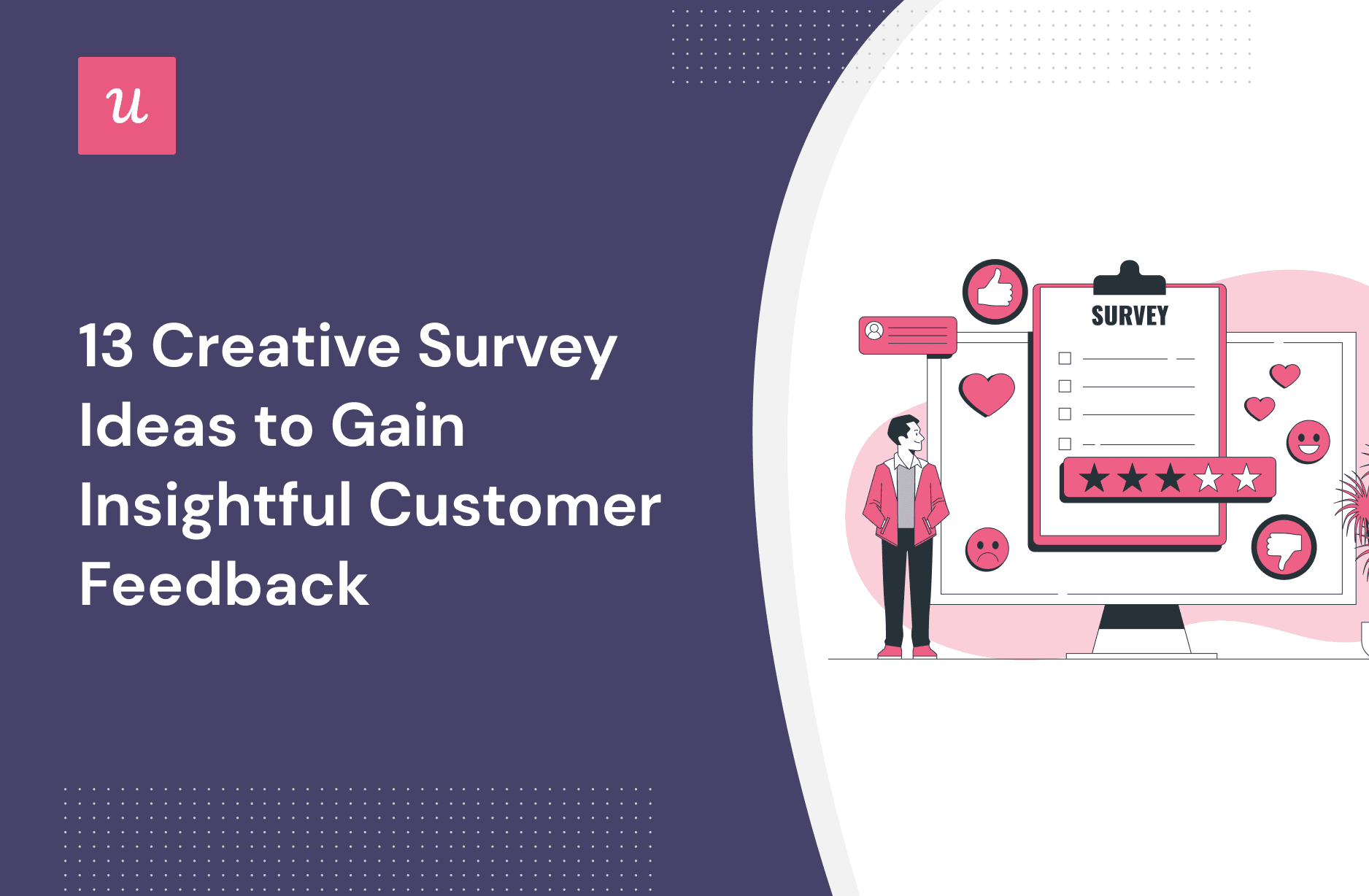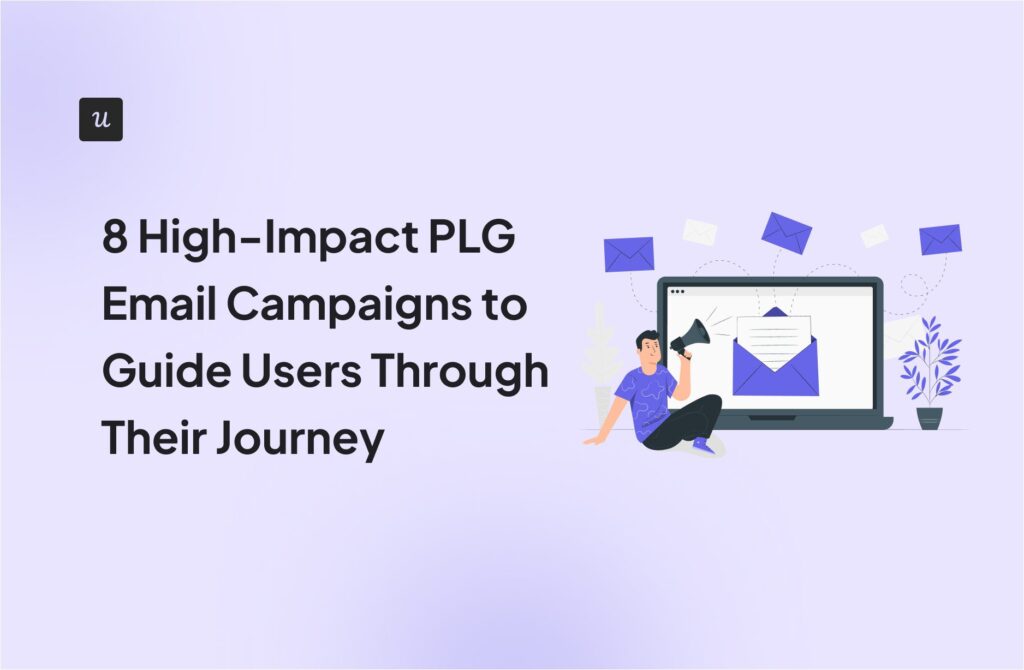
13 Creative Survey Ideas to Gain Insightful Customer Feedback
Whether you work in product management, customer success, or marketing, you need creative survey ideas to collect feedback that’s relevant, honest, and useful for your job.
Otherwise, you’d be working blindfolded and the success of your company might get compromised.
So to avoid survey fatigue and net higher response rates, we use 13 in-app survey ideas that bring valuable insights for customer experience, marketing, sales, and product growth.
Let’s go over them.
Get The Insights!
The fastest way to learn about Product Growth, Management & Trends.
Creative survey ideas for product management
For product management surveys, you want to measure the relationship between your customer and your product.
Thus, all the survey questions in this section will focus on your user’s sentiment around your product, and getting insights on how to improve it.
Ask for users’ overall experience with your product
This survey asks users to rate their overall experience with your product, using stars to quantify how satisfied they feel about it.
And although this question fits as a UX survey, it can give you an overview of your product management performance. Based on collected feedback, you can evaluate how effective your app is at satisfying the user’s needs.

Evaluate user experience when using your product
This survey asks users to rate from 1 to 5 how easy it is to use your product and allows you to measure your customer effort score.
One key component of a great product is its usability, so being able to gauge it with a short in-app survey can give you UX insights that can help you improve your product to better fit the user’s needs.

Gather user insights for feature research
Plenty of resources are invested in building new features, so they better the most value to customers.
With feature research, you can explore what future improvements your customers would like to see on your product with a 1-minute survey with open-ended questions.
This way, you can find out what parts of your product you should work on next and avoid falling into the feature fallacy trap.

Ask for user opinions to build product road maps
The best product-led companies allow customers to build their roadmap.
With a simple open-ended question, you can ask customers what features they need ASAP and what features can wait.
With the user’s responses, you can properly prioritize feature development and create a feedback-based public roadmap that aligns with your customer’s needs—building some hype for the next updates.

Measure your product-market fit
Haven’t confirmed if you have achieved product-market fit yet?
The Sean Ellis test is a widely accepted metric that can indicate product-market fit based on survey responses.
With this PMF survey, you ask customers how disappointed they would be if they could no longer use your product. And if at least 40% of your respondents say they will be very disappointed, you have achieved product-market fit.
So given the results of this survey, you can see if the demand for your product can sustain your business for the long term and grow healthy.

Creative survey questions for improving customer experience
Great customer experience is one of the many pillars of a successful product. So it’s essential to make UX a central research topic.
With these surveys, you can measure how customers interact with your app and check how satisfied they are with it.
Measure overall customer satisfaction with your product
By triggering a CSAT survey twice a year/annually, you can consistently get feedback on your customer satisfaction levels.
This survey directly asks customers how satisfied they feel with your product. And based on how many respondents choose the happy emojis, you can measure the percentage of happy customers.
Although more than 50% is ideally a good satisfaction benchmark, Retently’s CSAT benchmark showed that the average CSAT score of B2B SaaS businesses is 65%.
So, while you can try to stay above 50%, aiming for more than 65% is what’s going to keep you competitive in SaaS.

Understand customer experience after a specific interaction
The best way to know how users experience a specific aspect of your product is by asking them right after they use it.
This short survey simply asks how easy it is to perform a certain task with your app.
But, what makes it valuable is how granular and specific you can get with the question—allowing you to get more actionable insights for improving the customer experience.

Understand loyalty drivers with net promoter score questions
NPS surveys ask users to rate their likelihood of recommending your product to a friend on a scale of 0-10. Where users who scored 9-10 are considered “promoters,” and users who selected 0-6 are considered “detractors.”
To make NPS surveys even more insightful, you can add a follow-up question to dig deeper into what makes your users promoters or detractors. And then make the appropriate changes to improve the customer experience.

Collect customer feedback to improve customer service experience
If you intend to enhance the customer service experience, the best you can do is to trigger a survey right after a support ticket has been resolved.
With this survey, you can ask users how satisfied they feel with the interaction and leave any complaints if they have one.
This way, you can constantly receive feedback on your customer service process and find ways to improve it.

Creative survey research ideas for marketing
In marketing, having a clear definition of your target audience is key to bringing the right type of customers to the door.
Here are a couple of surveys you can use to better understand your audience.
Ask for company size to filter new users for growth marketing
Knowing your customer’s company size can give you a good idea of what plan would fit them better—while allowing you to personalize your marketing campaigns.
So, when onboarding a new customer, trigger a welcome survey to ask them about the size of their team. As well as other types of information such as their job title and goals.

Understand customer pain points with market research questions
If you want to further personalize your marketing, it’s also a good idea to ask market research questions about top challenges, pressing desires, and emotions.
With this valuable data, you can build a very deep customer profile and create marketing messages that resonate directly with their pain points, attracting good-fit customers that are likely to stay.

Creative survey ideas for sales
Knowing your ideal customer profiles in and out is part of what makes a high-performing sales team.
So here are some surveys you can use to better understand your leads and close more deals.
Collect feedback from closed customer deals
The best way to know why your customers bought your product is to ask them.
By sending this survey to new customers, you can quickly get feedback on what’s driving more conversions and see what selling points are the weakest.
This way, you can optimize your sales workflow and nurture your leads with the right messaging so they’re more likely to buy.

Determine potential customers using lead qualification questions
Qualifying leads represents a great part of sales everyday tasks. So, it can make wonders to send a survey that evaluates which leads are potential good-fit customers.
For this, you need to have a high-quality ideal customer profile (ICP) at hand, and then ask questions that correspond to each aspect of your target customers (JTBDs, job title, pain points, goals, etc).
This way, you’ll be able to identify which leads are the hottest and refine their experience to make them more likely to convert into paying customers.

Best practices to increase the survey response rate
Now, if you want to get the most out of these surveys, it is important to follow some good practices so your responses don’t look dead and your users don’t feel survey fatigue.
If you paid close attention to our few examples, you’ll notice that most of them follow at least a couple of these characteristics:
- Concise. Keeping surveys to their minimum expression makes them easier to answer and complete.
- Targeted to specific segments. Always send surveys with a relevant segment in mind, as there’s no use to ask new users about advanced features that only loyal customers would know about.
- Sent in-app. It’s way more convenient to trigger surveys in-app as users don’t have to leave your product to answer. Plus, it allows you to trigger them contextually when the user is most likely to provide helpful answers (e.g. triggering a satisfaction survey after a customer service interaction).
- On brand. So it fits your brand aesthetics and blends with the product UI (nothing worse than a survey that looks out of place).
- Properly automated. Using specialized software to trigger surveys automatically based on the user’s actions, milestones, and product behaviors. Allowing you to collect feedback passively.
How to create in-app online surveys with Userpilot?
Although you could send in-app surveys without any tool, we believe it’s way more convenient to adopt user feedback software (like Userpilot) to test ideas on the go without having to code or rely on your dev team.
So, here’s how you can build and send surveys with Userpilot in four steps:
- Build your surveys either from a template or from scratch.
- Choose a target audience based on their segment, specific conditions, or events.
- Analyze survey results for insights and actionable strategies.
Build your surveys using templates or starting from scratch
On Userpilot, you don’t have to start from scratch to create a survey (although you can if you wish to). There are many templates you can start with for almost every type of survey—including those we’ve covered in this article.
As for customization, you can easily design your survey to fit your brand’s aesthetics, and edit the text and answering methods (starts, numbers, emojis, etc) as you like.
Mobile surveys are a quick way to measure customer satisfaction, gather real-time feedback, and boost engagement.
In short, it is entirely possible to create and run a survey in a few minutes if you know what you’re doing.

Choose a target audience and configure your surveys
Once you’ve created your surveys, you can further configure them so they only trigger on specific paths and domains. As well as choose the recipient audience of the survey.
The audience can include:
- Specific segments that you’ve created earlier with welcome surveys.
- Users that match specific conditions and events.
- Customers who speak other languages (yes, you can easily localize your surveys).

Bonus: Analyze your survey results and gain actionable insights
After running surveys for a while, you can analyze your feedback with plenty of analytics tools that allow you to:
- Track metrics such as completion rate, average completion time, response rates, and so on.
- Compare survey performance between different segments and see how they respond to it.
- Analyze responses at a granular level, allowing you to check the results of each question (and even each user).

Conclusion
Collecting feedback is essential for growing any SaaS business. And with all the creative survey ideas we covered, all you need to do is take action.
So choose a tool, design your in-app surveys, and start gathering customer feedback so you can stop guessing how users perceive your product.
And given that you’ll need software for this, why not try a Userpilot demo to see how quickly you can build fun surveys with funny survey questions?





